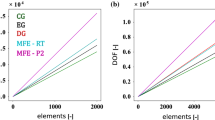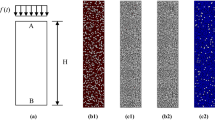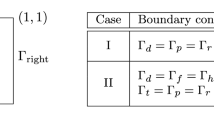Abstract
In this paper, we formulate a finite element procedure for approximating the coupled fluid and mechanics in Biot’s consolidation model of poroelasticity. Here, we approximate the pressure by a mixed finite element method and the displacements by a Galerkin method. Theoretical convergence error estimates are derived in a continuous in-time setting for a strictly positive constrained specific storage coefficient. Of particular interest is the case when the lowest-order Raviart–Thomas approximating space or cell-centered finite differences are used in the mixed formulation, and continuous piecewise linear approximations are used for displacements. This approach appears to be the one most frequently applied to existing reservoir engineering simulators.
Similar content being viewed by others
Explore related subjects
Discover the latest articles and news from researchers in related subjects, suggested using machine learning.References
Abousleiman, Y., Cheng, A.-D., Cui, L., Detournay, E., Roegiers, J.: Mandel’s problem revisited. Géotechnique 46, 187–195 (1996)
Biot, M.: General theory of three-dimensional consolidation. J. Appl. Phys. 2, 155–164 (1941)
Biot, M.: Theory of elasticity and consolidation for a porous anisotropic media. J. Appl. Phys. 26(2), 182–185 (1955)
Boyce, W., DiPrima, R.: Elementary Differential Equations, 7th edn. Wiley, New York (2001)
Brenner, S., Scott, L.: The Mathematical Theory of Finite Element Methods. Springer, Berlin Heidelberg New York (1994)
Coussy, O.: Poromechanics. Wiley, New York (2004)
Detournay, E., Cheng, A.-D.: Poroelastic response of a borehole in non-hydrostatic stress field. Int. J. Rock Mech. Mining Sci. 25, 171–182 (1988)
Evans, L.: Partial Differential Equations. American Mathematical Society, Providence (1998)
Gai, X.: A Coupled Geomechanics and Reservoir Flow Model on Parallel Computers. Ph.D. thesis, University of Texas at Austin (2004)
Garagash, D., Detournay, E.: An analysis of the influence of the pressurization rate on the borehole breakdown pressure. J. Solids Struct. 34(2), 3099–3118 (1997)
Gibson, R., Knight, K., Taylor, P.: A critical experiment to examine theories of three-dimensional consolidation. Eur. Conf. Soil Mech. 1, 69–73 (1963)
Hudson, J., Stephansson, O., Andersson, J., Tsang, C.-F., Ling, L.: Coupled T-H-M issues related to radioactive waste repository design and performance. Int. J. Rock Mech. Mining Sci. 38, 143–161 (2001)
Kim, J.-M., Parizek, R.: Numerical simulation of the noordbergum effect resulting from groundwater pumping in a layered aquifer system. J. Hydrol. 202, 231–243 (1997)
Langford, T.: Northwest Houston Sinking Faster than Coastal Areas. http://www.Reporter-News.com (1997)
Lewis, R.W., Schrefler, B.A.: The Finite Element Method in the Deformation and Consolidation of Porous Media. Wiley & Sons, Chichester (1987)
Lin, J.: An Interview with Jian Lin, Ph.D. http://www.esi-topics.com/earthquakes/interviews/JianLin.html (2003)
Liu, R.: Discontinuous Galerkin finite element solution for poromechanics. Ph.D. thesis, University of Texas at Austin (2004)
Lubick, N.: Modeling complex, multiphase porous media systems. SIAM News 5(3) (2002)
Mandel, J.: Consolidation des sols (étude mathématique). Géotechnique 30, 287–299 (1953)
Nedelec, J.: Mixed finite elements in ℝ3. Numer. Math. 35, 315–341 (1980)
Phillips, P.J.: Finite element methods for linear poroelasticity: theoretical and computational results. Ph.D. thesis, University of Texas at Austin (2005)
Phillips, P.J., Wheeler, M.F. : A coupling of mixed and continuous Galerkin finite element methods for poroelasticity II: the discrete-in-time case. Comput. Geosci. doi:10.1007/s10596-007-9044-z
Rajapakse, R.: Stress analysis of borehole in poroelastic medium. J. Eng. Mech. 119(6), 1205–1227 (1993)
Raviart, R.A, Thomas, J.W.: A mixed finite element method for 2nd order elliptic problems. In: Mathematical Aspects of the Finite Element Method. Lecture Notes in Mathematics, vol. 606, pp. 292–315. Springer, Berlin Heidelberg New York (1977)
Rivière, B., Wheeler, M.: Optimal error estimates applied to linear elasticity. Technical report, ICES Report. ICES, Austin (2000)
Roose, T., Netti, P., Munn, L., Boucher, Y., Jain, R.: Solid stress generated by spheroid growth estimated using a linear poroelastic model. Microvasc. Res. 66, 204–212 (2003)
Rutqvist, J., Tsang, C.-F.: Analysis of thermal–hydrologic–mechanical behavior near an emplacement drift at Yucca mountain. J. Contam. Hydrol. 62–63, 637–652 (2003)
Showalter, R.E.: Diffusion in poro-elastic media. J. Math. Anal. Appl. 251, 310–340 (2000)
Smillie, A., Sobey, I., Molnar, Z.: A hydro-elastic model of hydrocephalus. Technical report, Oxford University Computing Laboratory: Numerical Analysis Group, Oxford (2004)
Swan, C., Lakes, R., Brand, R., Stewart, K.: Micromechanically based poroelastic modeling of fluid flow in Haversian bone. J. Biomech. Eng. 125(1), 25–37 (2003)
Terzaghi, K.: Principle of Soil Mechanics. A Series of Articles. McGraw-Hill, New York (1926)
Verruijt, A.: Discussion. Proc. 6th Int. Conf. Soil Mech. 3, 401–402 (1965)
Wang, H.F.: Theory of Linear Poroelasticity with Applications to Geomechanics and Hydrogeology. Princeton University Press, Princeton (2000)
Wang, Y., Dusseault, M.: A coupled conductive-convective thermo-poroelastic solution and implications for wellbore stability. J. Petrol. Sci. Eng. 38, 187–198 (2003)
Weiser, A., Wheeler, M.: On convergence of block-centered finite differences and elliptic equations. SIAM J. Numer. Anal. 251(2), 351–375 (1988)
Wheeler, M.F.: A priori L 2 error estimates for Galerkin approximations to parabolic partial differential equations. SIAM J. Numer. Anal. 10, 723–759 (1973)
Wheeler, M.F., Phillips, P.J.: A coupling of mixed and Galerkin methods for poro-elasticity. In: Proceedings of the Second MIT Conference on Computational Fluid and Solid Mechanics, MIT, Cambridge, 17–20 June 2003
Zenisek, A.: The existence and uniqueness theorem in Biot’s consolidation theory. Aplik. Matem. 29, 194–210 (1984)
Author information
Authors and Affiliations
Corresponding author
Rights and permissions
About this article
Cite this article
Phillips, P.J., Wheeler, M.F. A coupling of mixed and continuous Galerkin finite element methods for poroelasticity I: the continuous in time case. Comput Geosci 11, 131–144 (2007). https://doi.org/10.1007/s10596-007-9045-y
Received:
Accepted:
Published:
Issue Date:
DOI: https://doi.org/10.1007/s10596-007-9045-y




